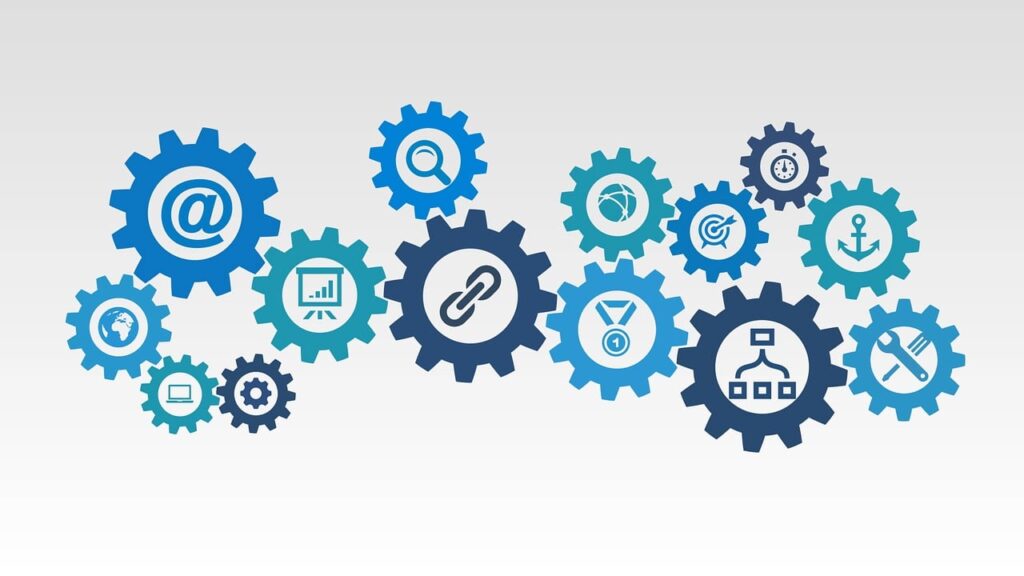
Similar to living creatures in a biological ecosystem, companies live in a business ecosystem. According to James Moore, a business ecosystem is an economic community supported by a foundation of interacting organizations and individuals – the organisms of the business world.
A business ecosystem is characterized by three aspects. First, there’s a symbiotic relationship between the organizations and individuals. This means that everyone in the ecosystem is better off inside than outside. It’s the responsibility of the keystone players to make sure of this as companies and individuals will leave otherwise.
The second characteristic is co-evolution. All parties need to continuously evolve to stay relevant for the ecosystem’s end customers. However, this evolution needs to be coordinated to ensure compatibility between all involved. Of course, we can define decoupling interfaces that allow some parties to evolve independently of others, but that tends to only allow for some decoupling in time. Eventually, evolution needs to occur on both sides of such an interface.
Third, business ecosystems tend to be organized around some kind of platform. This platform may consist of tools, services and technology used in the ecosystem to enhance performance. It’s the platform that allows the business ecosystem to create an “unfair advantage” that results in superior performance inside the ecosystem as compared to outside it.
One often discussed ecosystem is the Apple iOS ecosystem with all the app providers monetizing their apps there. Since end customers with iPhones spend significantly more money on apps as compared to competing ecosystems such as Android, there’s a clear benefit for app developers to be in the Apple ecosystem. As iOS evolves and new phone types become available, app developers need to continuously evolve their apps to stay compatible. And, of course, iOS is literally the platform that allows for the unfair advantage with millions upon millions of people using iPhones.
Although a clean, easy-to-understand narrative, it’s also misleading in that it’s way too simplistic. Each player in the iOS ecosystem, including Apple, is not only part of that ecosystem but also of several other ecosystems. Each of the apps provides functionality that relates to another ecosystem. For instance, your banking app connects to your bank and all the investment, payment and saving solutions offered by it. Your Linkedin app connects you with all the players in the Linkedin ecosystem ranging from recruiters to sellers and peers. Your parking app relates to the physical space in your immediate surroundings and the places you can park and pay for parking your vehicle.
Those ecosystems are, in turn, connected to several other ecosystems. For instance, your banking app connects also to the financial investing ecosystem where numerous players are running index funds, ETFs, stock market exchanges, and so on. And, of course, the financial investing ecosystem is, in turn, connected to real-world companies.
Many people I talk to tend to oversimplify the notion of their business ecosystem and treat it as an independent entity that can be understood and reasoned about in isolation. This leads to several ecosystem traps that many fall into, including the “descriptive versus prescriptive” trap, the “assumptions” trap and the “doing it all at once” trap.
The first trap is to assume the ecosystem is cast in stone and immutable. When you assume the interfaces between the partners in the ecosystem are static and a given, there’s no need to prepare for changing interfaces nor do you even try to change your position in the ecosystem. Instead, an ecosystem represents an equilibrium of forces and when there’s a shift in those forces or you can achieve one, the interfaces in the ecosystem will shift too.
The “assumptions” trap is where keystone players, in particular, make overly simplistic assumptions about partners in the ecosystem. A typical example is where a partner is viewed as a single entity instead of realizing that sales, operations, R&D and other roles in the partner organization may all have different drivers and needs. Ignoring this may easily cause suboptimal relationships with these partners and unexpected failure of initiatives as some key stakeholders on the partner side effectively block progress.
Finally, the “doing it all at once” trap is concerned with the deadlock that many fall into when they try to make changes to their business ecosystem. As everything is connected to everything else, it easily results in a perception that everything has to change at the same time. As that’s impossible, the consequence is a deadlock and a belief that things are immutable, resulting in the first trap.
For businesses looking to become platform companies with a two-sided or multi-sided ecosystem on top of their offering, the challenge becomes even more interesting as both sides of the ecosystem need to be built at the same time. In general, research shows that it’s much easier to build up one side of the ecosystem first and then start adding other sides.
No company operates in a single business ecosystem or software ecosystem; every company operates in many overlapping, interconnected ecosystems. Focusing too much on “the ecosystem” is a gross simplification that can easily cause you to lose sight of the true complexity. There are several traps that companies may fall into when dealing with their business ecosystems. Instead, aim to understand the true complexity, focus on small-scale experiments to evaluate various strategies and take small steps to continuously improve your position in the ecosystem. To quote Pearl Zhu: “A business ecosystem is just like the natural ecosystem; first, needs to be understood, then, needs to be well planned, and also needs to be thoughtfully renewed.”
Want to read more like this? Sign up for my newsletter at jan@janbosch.com or follow me on janbosch.com/blog, LinkedIn (linkedin.com/in/janbosch), Medium or Twitter (@JanBosch).